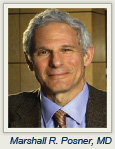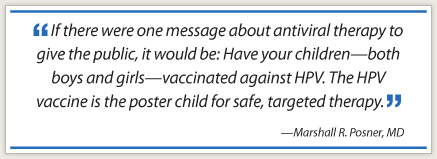 Although head and neck cancer remains a major therapeutic challenge, significant advances have been made over the past few decades. The ASCO Post recently spoke with Marshall R. Posner, MD, Medical Director of the Head and Neck Oncology Program, Mount Sinai Medical Center, New York, about the current state of therapies and exciting new opportunities in this difficult-to-treat disease.
Although head and neck cancer remains a major therapeutic challenge, significant advances have been made over the past few decades. The ASCO Post recently spoke with Marshall R. Posner, MD, Medical Director of the Head and Neck Oncology Program, Mount Sinai Medical Center, New York, about the current state of therapies and exciting new opportunities in this difficult-to-treat disease.
Treatment-related Morbidity
Treatment-related morbidity in head and neck cancer is a major challenge for clinicians. Are we making headway?
Yes. Primary treatment modalities—surgery and radiation—have produced significant improvements in morbidity. Transoral robotic surgery has reduced trauma and tissue damage associated with deep resections within the oropharynx and larynx, thus improving functional outcomes and changing the way we approach early-stage cancers.
Also, intensity-modulated radiation therapy (IMRT) has significantly changed radiation therapy for intermediate cancers that once resulted in fairly extensive salivary gland damage. IMRT does have limitations in advanced cancer, in that you cannot always rescue the contralateral parotid glands. And despite some overreach in clinical claims, we have seen improvements in xerostomia.
However, the major problems with radiotherapy remain. Intensive radiation therapy has a long-term, profound impact on mortality and quality of life. Now that the epidemiology of head and neck cancer has substantially changed and we’re treating patients with human papillomavirus (HPV)-related oropharynx cancer, most of whom are going to survive for decades, it is unacceptable to prolong life without seriously considering how to prevent these long-term side effects.
From a chemotherapy perspective, in the modern age we have not seen major long-term consequences from cisplatin/fluorouracil–based induction chemotherapy or the addition of taxanes to induction therapy, and we have seen a significant improvement in survival. Because these treatments have been available in the curative setting for about 15 years, we have a good idea about long-term consequences.
Chemoselection
Investigators from the University of Michigan Comprehensive Cancer Center use the term chemoselection to describe their strategy for achieving organ preservation. Can you please discuss this approach?
I believe the Michigan group is mistaken in their premise that the response to chemotherapy should only be the basis for decisions about which patients receive radiation as primary therapy, as opposed to using chemotherapy for its intended purpose—to shrink the primary tumor, improve locoregional control, reduce the risk of distant metastases, and improve survival.
The original paper on cisplatin-based chemoradiotherapy, by Ensley et al,1 demonstrated that induction chemotherapy did not enable the selection of radiosensitive patients. Rather, it was found that patients resistant to chemotherapy are also resistant to radiotherapy—the addition of cisplatin chemotherapy to radiotherapy in the setting of primary resistance to a cisplatin/fluorouracil regimen added an extra element of efficacy and increased survival in those resistant patients.
So, on the one hand, induction chemotherapy predicts radiotherapy resistance, allowing us to modify the radiation or chemoradiotherapy course, but it also improves locoregional and distant metastatic control in the majority of patients. The notion that you can give one cycle, determine the patient’s response, and move to radiation or surgery, eliminates the direct benefits of induction therapy.
Ongoing Debate
In the debate over the role of induction therapy, the Michigan group cited the Radiation Therapy Oncology Group (RTOG) 91-11 study. Can you add clarity to this ongoing clinical debate?
I want to make something very clear about this important issue. The 2003 report on laryngeal cancer treatment by the RTOG in The New England Journal of Medicine2 was premature and proved to be misleading. In 2006, the RTOG reported the 5-year follow-up data demonstrating that induction chemotherapy and chemoradiotherapy were virtually identical in laryngectomy-free survival, the primary endpoint of the study.3 There was even a minor survival advantage for induction chemotherapy.
It is a serious problem—and reflects the priorities of the RTOG head and neck cancer committee—that they have not officially published a complete report of the data for serious analysis, holding off its publication for more than 5 years since the original abstract was reported at the ASCO Annual Meeting.
Among other things, this study demonstrates that one should evaluate outcomes in head and neck cancer trials over a longer period—perhaps 5 years—given that some major conclusions in the original report were found to be erroneous with longer follow-up. In addition, it is more than disappointing that the later data have been withheld. If a pharmaceutical firm had such data and had not published the change in survival and outcomes with longer follow-up, it would have raised serious conflict-of-interest questions.
The oncology community deserves to see the outcomes of this study. I am also worried about the availability for peer review of later complete results from other studies such as RTOG 01-29, for which later data should now be available.
HPV-related Head and Neck Cancer
Please give the readers an update on HPV-related head and neck cancers?
 We clearly have an HPV epidemic in this country and in Europe, predominantly in the male population. Whether this is the result of a shift in sexual mores or a subtle change in the environment, or both, it has had a major impact on the survival of patients we are now seeing.
We clearly have an HPV epidemic in this country and in Europe, predominantly in the male population. Whether this is the result of a shift in sexual mores or a subtle change in the environment, or both, it has had a major impact on the survival of patients we are now seeing.
Based on previous data and our most recent clinical trials in advanced disease, we might have expected a 50% to 60% survival for otherwise healthy patients with oropharynx cancer. However, if we tease out the HPV-positive population, what we see is about a 65% to 80% survival at 3 and 5 years vs a 35% to 45% survival in the non-HPV population. That means that our major prognostic indicator for survival is HPV positivity. No other molecular marker has the prognostic power of HPV tumor status.
Unfortunately, HPV is not currently a predictor for therapy, because we don’t have the clinical trials addressing this question. We also lack a more thorough understanding of the biology of HPV-related oropharynx cancer. We do have behavioral markers. For instance, smoking is heavily related to failure in HPV-positive patients, but we don’t have a biomarker that correlates with or predicts therapeutic outcome of oropharynx cancer within the HPV-positive population.
So, for the first time, we have the ability to separate head and neck cancers into two distinct diseases with different biologies and prognoses. We know that we can dramatically improve local control in the HPV-positive population and that the vast majority of the survival benefits that we’re seeing is due to improved locoregional control with chemotherapy and radiation.
Our clinical experience also suggests that there may be improved locoregional control with HPV and better functional outcome with the new surgical technology. This is important because we may be able to withhold or reduce the amount of radiation administered in these younger patients and reduce the long-term consequences of treatment-related toxicity. Although we are eager to find ways to reduce treatment intensity, we don’t as yet have the clinical trial data in the form of phase III or robust phase II trials to support specific methods to reduce radiation exposure.
In the next decade, we will see a host of vaccines, immune modulators, and other HPV-specific targeted therapies, which, after being tested, may actually allow us to eliminate the use of chemotherapy or radiotherapy in the population of intermediate- and advanced-stage patients. I would very much like to turn the treatment of HPV-related oropharynx cancer back to the internist.
Other Viruses
Are there other important viral connections that will help us in prevention and treatment of head and neck cancers?
Epstein-Barr virus (EBV) is a sexually transmitted disease that is the principal cause of nasopharynx cancer worldwide, causing about 65% of cases in the United States. It is an extremely early event in the carcinogenic process, and yet completely different from human papillomavirus. EBV has a much larger and more complex genome and is very hard to study in vitro. However, like HPV, EBV is highly responsive to chemotherapy.
Since it is a major disease in China and Southeast Asia, I think that the increasingly sophisticated Chinese research apparatus is going to be investigating EBV intensively. Through our U.S. biotech firms, we have a golden opportunity to get on board and be a part of that process, particularly with immune-modulating therapies.
I hope that in the future, preventive vaccines for HPV and EBV will lead to complete eradication of the cancers related to these viruses. If there were one message about antiviral therapy to give the public, it would be: Have your children—both boys and girls—vaccinated against HPV. The HPV vaccine is the poster child for safe, targeted therapy.
Current Research
What current research activities are you involved in?
I’m collaborating with Gypsyamber D’Souza, PhD, MPH, MS, of Johns Hopkins Bloomberg School of Public Health, on a large trial looking at the epidemiology and transmission of HPV-positive oropharyngeal disease through saliva. With Karen Anderson, MD, PhD, of Arizona State University, I’m studying antibody responses and developing a potential diagnostic test, which may also have some predictive capacity for subsets and biology of HPV.
We’re also working with the Baylor Institute of Immune Research to try to develop a long peptide dendritic-based therapeutic vaccine for HPV. We’ll initially enlist surgical candidates to evaluate immune responses, both at the antibody and cell-specific level. The end goal is to develop potential biologics to enhance immunity for vaccination recipients and for patients with active disease.
In the area of supportive care, we’re working with a number of companies looking at agents designed to reduce mucositis during radiation. We’re happy to see some of the data coming back on palifermin (Kepivance) in reducing radiation-induced mucositis.
Finally, we are developing a phase III trial at Mount Sinai Medical Center to ask if it is possible to safely give reduced radiation doses to patients with locally advanced HPV-positive oropharynx cancer.■
Disclosure: Dr. Posner has consulted for Eisai, GlaxoSmithKline, Novartis, and Oxigene.
References
1. Ensley J, Ahmed K, Kish J, et al: Salvage of patients with advanced squamous cell cancers of the head and neck (SCCHN) following induction chemotherapy failure using radiation and concurrent cisplatinum (CACP), in Salmon S (ed): Adjuvant Therapy of Cancer VI, pp 92-100. Philadelphia, WB Saunders Company, 1990.
2. Forastiere AA, Goepfert H, Maor M, et al: Concurrent chemotherapy and radiotherapy for organ preservation in advanced laryngeal cancer. N Engl J Med 349:2091-2098, 2003.
3. Forastiere AA, Maor M, Weber RS, et al: Long-term results of Intergroup RTOG 91-11: A phase III trial to preserve the larynx--Induction cisplatin/5-FU and radiation therapy versus concurrent cisplatin and radiation therapy versus radiation therapy. J Clin Oncol 24(18S):Abstract 5517, 2006.

